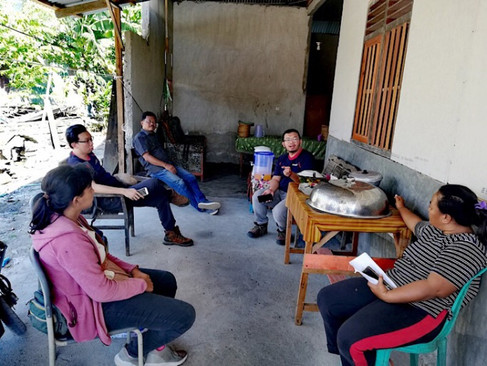CENTRAL SULAWESI EARTHQUAKE & TSUNAMI (3-10 JUN)
- Admin
- Jul 1, 2019
- 4 min read
Updated: Mar 9, 2023
Background 6 months after our trip in January 2019, it was time to send a team to follow up on the progress of our transitional shelters building project and to look into possible livelihood projects for the earthquake and tsunami survivors.
Objective
1. To provide status report on the 390 transitional shelters from 2 locations, Jono Oge & Kulawi.
2. To gather more information and finalise possible livelihood project with local.
Team Members
Leader & Photo - CK Cheong
Treasurer & Travel Log – Chiew Li Yuen
Travel Events
Date Event
03 July 2019
1300 – 1405 Arrive at Jakarta Terminal 2 from KLIA. We travel on Lion Air, transit in Jakarta before heading to Palu.
1405 – 1700 Lunch at airport. We took the sky train to transit from terminal 1 to terminal 2. Check with the information counter from time to time, because the schedule and gate number keeps changing without updating on the information board.
1700 – 2125 Arrive at Palu airport. Met with our local coordinator, Mr Deky.
2125 – 2230 Dinner at Mee Garing. Check in at Rego hotel and rest.
04 July 2019
0830 – 0900 Breakfast at hotel, short briefing.
0900 – 1030 Check out and change money from USD to Rp at BCA bank. Buy grocery at Alfamidi.
1045 – 1130 Visit our local partner - MDS base.
1130 – 1230 Visit earthquake affected areas around Palu beach, met with another NGO from Melaka.
1230 – 1400 Lunch together with MDS church at Depot 88.
1400 – 1730 Depart for Kulawi, Sulawesi. Stop at Salvation Army church at Salua for a break.
1730 – 1830 Arrive at MDS base in Kulawi and rest.
1830 – 1930 Dinner.
1930 – 2100 Interview local partner regarding their response before, during and after the earthquake on September 2018.
2100 – Sleeping time.
05 July 2019
0700 – 0900 Breakfast and depart for Desa Lonca.
0900 – 1230 Arrive at home of village leader, Pak Tony at Desa Lonca (S 1 29,723’; E 119 58.216’).
1330 – 1530 Visit Mr Salmon Tosupu, head of village at Desa Sungku (S 1 28.445’; E 119 59.995’).
1530 – 1830 Visit Balai Penyuluhan Pertanian Perikanan, Desa Lawua (S 1 37.020’; E 120 2.501’) and met with Pak Alfonso for rice planting livelihood project assessment.
1830 – 2030 Visit Desa Boladangko and met with Pak Udin, head of village. The major problem is lack of mosquito nets and unstable electricity supply.
2030 – Return to base, dinner and rest.
06 July 2019
0700 – 1130 Breakfast and depart for Palu
1130 – 1400 Check in Rego hotel and lunch.
1400 – 1700 Depart for Jono Oge (S 0 58.565’; E 119 54.642’). Conduct workshop “Mitigasi & Pengurangan Risiko Bencana Dikalangan Pemuda Desa Jono Oge”.

Disaster Risk Reduction Workshop

Group Photo with Local Community
1700 – 1800 Fellowship with Salvation Army church members.
1800 – 2000 Dinner and rest.
07 July 2019
0630 – 0700 Depart for Jono Oge.
0700 – 0830 Sunday service at Gereja Bala Keselamatan KORPS, Jono Oge, Jl. Sandro – Desa Jono Oge Divisi Palu Timur.
0830 – 0930 Breakfast, visit Desa Jono Oge.
1300 – 1400 Lunch.
1400 – 1700 Continue to visit villagers in Jono Oge. Assessment for possible livelihood projects.
1700 – 1900 Back to Palu, dinner and rest.
08 July 2019
1000 – 1130 Breakfast.
1130 – 1300 Repair car, at the same time meet with Pak Yewin, who knows some candidates who can handle Jono Oge’s livelihood project starting from August. He recommended Mr. Mato.
1300 – 1700 Visited Petobo, which was affected by liquefaction.
1700 – 1900 Went to MDS church to get updated database for shelter building.
1900 – 2000 Dinner and rest.
09 July 2019
0900 – 1000 Breakfast and depart for Petobo.
1000 – 1200 Conduct survey of government transitional shelters (S 0 55.982’; E 119 55.886’), and look for water sources for that area.
1200 – 1400 Visit Jono Oge to follow up on livelihood project.
1400 – 1800 Consolidate project report and conducted possible livelihood plans for Jono Oge.
Activities
1. Transitional Shelter
Location: Kulawi Transitional Shelter: 250 units (138 completed, 112 in progress) Status: Desa Lonca (16 completed, 29 in progress)
Desa Sungku (7 completed, 37 in progress)
Desa Boladangko Dusun 1 (75 completed, 1 in progress)
Desa Boladangko Dusun 2 (38 completed)
Desa Bolapapu (2 completed)
Desa Matauwe (45 in progress)
Desa Lonca. 16 out of 45 transitional shelters have been completed. There are 148 households, with a population of 554 in this Desa. 90 out of 148 of houses were heavily damaged. According to the village head, relief teams arrived a month after the earthquake. The villagers were completely isolated due to landslide, government aid arrived 1 month after.
During the isolation period, the survivors evacuated to the field and used the tarpaulin which they used to dry their cocoa seeds as to make temporary shelters. They have enough food supply and water supply (from bamboo) to survive for a month. However, electricity supply was cut off for 2 months.
Livelihood in Desa Lonca depends mainly on agriculture. 90% of the villagers depend on farming as a source of income. They plant cocoa trees and harvest the seeds to sell in Palu. Recently, the harvests were decreasing due to weather chnages (more rain, less harvest). Currently, the price of cocoa is ranges from Rp 28,000 to 29,000 per kg, compared to Rp 24,000 to 30,000 per kg before. This is due to the supply chain mechanism (involvement of middle man). Besides cocoa, the farmers also plant durian, avocado and vanilla as secondary crops.
Desa Sungku. There are 362 households with a population of 1,279 in this village (9 km along the road). 90% of the villagers are farmers, they plant cocoa, maize, and durian. The harvest has decreased due to the earthquake. The head of the village recommended to plant vanilla or chili for better income.
Our proposal – Desa Sungku to set up a union / business centre and act as a trading agent to sell their produce in Palu. Difficulties faced in Desa Sungku:
Transportation
Difficult to sell, low market value, low selling price
Lack of knowledge in trading products
Lack of human resource
Location: Jono Oge
Transitional Shelter: 140 units (134 completed, 6 in progress)
Status:
Dusun 4 (66 completed, 3 in progress)
Dusun 5 (68 completed, 3 in progress)
We interviewed few households in Jono Oge,
Pak Idrinarus. He has 2 sons, he built his temporary shelter just beside his previous house. However, he still keeps his valuable items in his previous house. The temporary shelter does not have a lock and has been burglared before.
Pak Jerey. He lost his son in the earthquake. He had built the temporary shelter within a week. He rears pigs just beside his house. The piglet takes 9 months to mature and ready to sell. The buyer will come and buy the pig from him.
2. Livelihood Assessment
Jono Oge, Dusun 4 – The main source of income here is pig farming. During our visit, we came across buyers who had traveled 955km from Manado City (Northern Sulawesi) to buy pigs. Residents from Kulawi (South of Central Sulawesi) also come here to buy the pigs.
Petobo, Posko 6 – 44 villagers were reported to have died here in the liquefaction. There are 300 households in this posko. The head of the posko, Pak Mukadas has received official letter from the government for the villagers to be relocated to Palu City. The villagers refused to do so because they are farmers and do not have farmland in the new area. Besides, they want to maintain the facilities they have built in Petobo (such as mosque, school and football field).
Ibu Hatini who stays in Posko 6 is also a survivor from Petobo. She is staying here with her husband, 6 children and her mother. The major difficulty she encounters is the water source. To get water, she has to travel 300 meters away from her transitional shelter. Every 2-3 days, the local government will deliver water to them via truck.
Recommendation
1. Pig Farming at Jono Oge
1 Month Piglet – Rp. 800,000 to 900,000 = Rp. 850,000 5 Month Food – 300kg, Rp. 4,000 per kg = Rp. 1,200,000 5 Month Pig – 90kg, Rp. 34,000 per kg = Rp. 3,060,000 5 Month gross profit = Rp. 1,010,000
If a household wanted to start this business, they need to have a pair of piglet (male and female). So the offspring of the piglets will be a continuous income for the household.
We proposed to start from a small community of 5 households. Each household need to invest a capital of Rp 1,000,000 and each of them will receive:-
2 x 1 Month of Piglets
2mx2m of Odorless Piggery Farming
Dig 1 meter hole (2x2) insert old wood or decomposing wood.
On top of that, we can lay rice hull (best) or wood dust.
Spread salt, carbon, and local liquor which called saguer here (this is to produce bacteria inside the system).
Cover with another layer of rice hull and salt, carbon and saquer
Repeat step 2 and 3 for 3 times (4 layers).
With conditions:-
Not to sell any pig within the 5 months period. Selling the pigs within 5 months shall be considered as breach of contract and the capital of Rp. 1,000,000 shall be forfeited. A police report shall be made for breach of trust.
To continue with the project, they shall raise at least 1 new generation of piglets from the given pigs.
After the first generation of piglets, they may give their piglet back to the community and the capital shall return to them at a rate of Rp. 500,000 for 1 piglet. Maximum is 2 piglets.
If this pilot project is successful and is proven to be sustainable, CREST will consider to extend it to the rest of the villagers.
2. Transitional Shelter will be completed by August 2019. We welcome our donors to visit the beneficiaries in November 2019.

















